Please refer to Assignments Class 10 Science Magnetic Effect of Electric Current Chapter 13 with solved questions and answers. We have provided Class 10 Science Assignments for all chapters on our website. These problems and solutions for Chapter 13 Magnetic Effect of Electric Current Class 10 Science have been prepared as per the latest syllabus and books issued for the current academic year. Learn these solved important questions to get more marks in your class tests and examinations.
Magnetic Effect of Electric Current Assignments Class 10 Science
Very Short Answer Type Questions :
Question. Why does the bulk of iron fillings slick to the ends of a bar magnet and not at its centre?
Answer: Because at the ends magnetic strength is maximum and at canters magnetic strength is least.
Question. What is an electromagnet? Write two uses of an electromagnet?
Answer: When current is passed through a solenoid it behaves as a magnet and is called as an electromagnet.
The two uses of an electromagnet are-
(1) They are used to lift heavy iron pieces.
(2) They are used in many devices like micro phone, radio sets, electric bell etc.
Question. A positively charged particle (alpha-particle) projected towards west is deflected towards north by a magnetic field. The direction of magnetic field is (a) towards north (b) towards east (c) downward (d) upward
Answer: (d) Upward (Apply Fleming’s left hand rule).
Question. Name the type of current:
(a) used in household supply. (b) given by a cell.
Answer:
(a) Alternating current. (b) Direct current.
Question. Give one application of electromagnetic induction.
Answer: This phenomenon is used in electric generator.
Question. A charged particle enters at right angle into a uniform magnetic field as shown. What should be the nature of charge on the particle if it begins to move in a direction pointing vertically out of the page due to its interaction with the magnetic field?
Answer: Using Fleming’s left hand rule, the nature of charged particle is positive.
Question. Name any two appliances which are based on the application of heating effect of electric current.
Answer: Room heater and geyser.
Question. Name the physical quantities which are indicated by the direction of thumb and forefinger in the Fleming’s right hand rule?
Answer: In Fleming’s right hand rule, thumb indicates — direction of motion of the conductor; forefinger indicates — direction of magnetic field.
Question. If the no. of turns of a circular current carrying coil are doubled, then how will the magnetic field produced by it changes?
Answer: Doubled
Question. State two properties of magnetic lines of force?
Answer: (i) Magnetic lines of force are closed continuous curves.
(ii)The tangent at any point on the magnetic line of force which gives the direction of magnetic field at that point.
Question. Draw magnetic field lines around a bar magnet? Give one point of difference between uniform and non- uniform magnetic field.
Answer: The space or region where field is same everywhere is known as Uniform magnetic field. The magnetic field which is unequal in magnitude and direction at every point in the space is called non- uniform magnetic field.
Question. Name some sources of direct current.
Answer: Some sources of direct current are a cell, a battery and a D.C. generator.
Question. If the current is flowing in the direction of advancement of screw, then what is the direction of magnetic field lines?
Answer: In the direction of rotation or screw.
Question. A current through a horizontal power line flows in north to south direction. What is the direction of magnetic directly above it? field (i)at a point directly below it and (ii)at a point
Answer: (i) West to East (ii) East to West
Question. Electric appliances like electric -press, toaster, fans etc are connected to electric mains through three-pin plug. Why?
Answer: Electric appliances are connected to three pin plug because heavy appliances require earth wire, so that in case of leakage of any current it goes to earth and user will not get shock.
Question. A current carrying conductor is placed perpendicular to the uniform magnetic field.
What happens to displacement of the conductor if (i) strength of current increases
(ii) If horse shoe magnet is replaced by a weak horse shoe magnet.
Answer: The displacement of the conductor
(i) will increase on increasing the current
(ii) Will decrease on using a weak horse shoe magnet.
Question. How can you say that the magnetic field is uniform inside the solenoid.
Answer: Because field lines are parallel inside the solenoid.
Question. Why do not two magnetic field lines intersect each other?
Answer: The two magnetic field lines never intersect each other because at the point of intersection there will be two directions of magnetic field, which is not possible.
Question. Name any two devices which use permanent magnets.
Answer: Loudspeakers, (Galvanometer, voltmeter).
Question. Identify the poles of the magnet in the given figure.
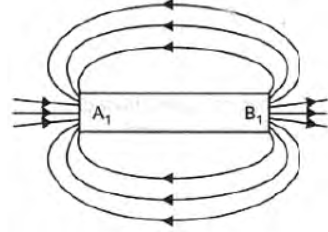
Answer: A1 is North Pole, B1 is South Pole because magnetic field lines goes from north pole to south pole of the magnet.
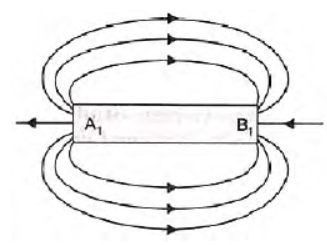
Question. A compass needle is placed near a current carrying wire. State your observation for the following cases and give reason for the same in each case:
a. Magnitude of electric current in the wire is increased.
b. The compass needle is displaced away from the wire.
Answer:
a. Compass needle is deflected more because more the current, more the magnetic field near the wire.
b. Magnetic field strength is inversely proportional to the distance from current carrying wire. So deflection will decrease in the compass needle when brought away from wire.
Question. Draw a diagram to represent a uniform magnetic field in a given region.
Answer: Uniform magnetic field is represented by equidistant parallel lines.

Question. Draw the patterns of magnetic field fines due to a bar magnet. The magnetic field fines are closed curves. Why?
Answer: Magnetic field lines emerge out from the N-pole of a bar magnet go to the S-pole and inside the magnet field lines goes from S-pole to N-pole thus form the closed curves.
Question. How can it be shown that a magnetic field exists around a wire through which a direct current is passing.
Answer: When we put a small magnetic compass near a current carrying conductor it gets deflected, which shows that a magnetic field is produced near a current carrying conductor.
Question. Mention the voltage and frequency of current that we receive at our house.
Answer: In our house we get AC of voltage 220 V and frequency 50 Hz.
Question. Name two safety measures commonly used in electric circuits and appliances, what precautions should be taken to avoid the over loading of domestic electric circuits?
Answer: Proper earthing and using a fuse load in the electric circuit must be as per rating of the fuse and do not connect to many plugs in a single socket.
Question. Name the type of current: (a) used in household supply (b) given by a cell.
Answer:
a. We use alternating current in our houses which changes to direction and magnitude with time.
b. A cell supply direct current (DC) or unidirectional current which flows only in one direction only.
Question. If field lines of a magnetic field are crossed at a point, what does it indicate?
Answer: If the magnetic field lines would cross each other then at the same point there would be two directions of magnetic field which is not possible.
Question. (a) A compass needle gets deflected when brought near a current carrying conductor. Why?
(b) What happened to the reflection of needle when current in the conductor is increased?
Answer:
(a) Near a current carrying conductor a magnetic field is produced which deflect the compass.
(b) With the increase in strength of current in the conductor strength of magnetic field also increases so there will be more deflection in compass.
Question. An alternating electric current has a frequency of 50 Hz. How many times does it change its direction in one second?
Answer: 50 Hz ac changes its direction 100 times in 1 sec.
Question. What will be the frequency of an alternating current if its direction changes after every 0.01 ?
Answer: The direction of ac changes every 0.01 sec.
Thus time of one complete cycle = 0.02 sec
i.e. in 0.02 sec no. of cycle = 1
in 1 sec no. of cycle = 1/0.02 = 100/2 = 50
Frequency of ac = 50 Hz
Question. Mention the shape of the magnetic field lines around a current carrying straight conductor.
Answer: The magnetic field lines around a current carrying straight conductor are in the form of concentric circular rings around a conductor.
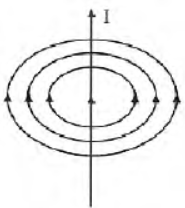
Question. What constitutes the field of a magnet?
Answer: The magnetic field is created by the magnet or when a charge particle is moving with some velocity in both cases they produce a magnetic field around them. The magnetic field is due to current or magnetic material.
Question. How can you show that the magnetic field produced by a given electric current in the wire decreases as the distance from the wire decreases?
Answer: If we bring a magnetic compass from a distance to near a current carrying conductor its deflection goes on increasing and when magnetic compass is brought away from the current carrying wire its deflection goes on decreasing which shows that magnetic field near current carrying wire is maximum and decreasing on increasing the separation.
Question. What is the pattern of field fines inside a solenoid?
What do they indicate?
Answer: The magnetic field inside a solenoid is uniform in the form of parallel lines.
Question. When is the force experienced by a current carrying conductor placed in a magnetic field the maximum?
Answer: A current carrying conductor experience maximum force in a magnetic field when the direction of current is perpendicular to the magnetic field.
Question. How is the induced current in a secondary coil related to current in a primary coil?
Answer: Induced current in a secondary coil may be more or lesser than the current in primary coil depending upon the number of turns in secondary.
Question. How is the strength of the magnetic field at a point near a wire related to the strength of the electric current flowing in the wire?
Answer: The magnetic field strength at a point near a wire is directly proportional to the current strength in the conductor.
Question. What is the advantage of the third wire of earth connection in domestic appliances?
Answer: In case of any electric fault in domestic appliances, current may comes in appliance body. The third wire called earth wire transfer this current to the earth and user remains safe from any such electric shock.
Short Answer Type Questions :
Question. (a) What is the direction of magnetic field lines inside a bar magnet and outside of it?
(b) What does the degree of closeness of the field lines represent?
Answer: The direction of magnet lines of force inside a bar magnet is from S-pole to N-pole.
Question. What is meant by the term ‘frequency of an alternating current’? What is its value in India?
Why is an alternating current considered to be advantageous over direct current for long range transmission of electric energy?
Answer: Frequency of Alternating current is equal to the number of cycles completed in one second.
In India, frequency of AC is 50 Hz i.e. 50 cycles per second.
An alternating current is considered to be advantageous over direct current for long range transmission of electric energy because it can be transmitted over long distances to distant places without much loss of electric power as compared to direct current.
Question. Explain any two situations that can cause electrical hazards in domestic circuits.
Answer: (i) Connecting too many electrical devices to a single socket or in the extension cord for any length of time draws high current from the mains that will exceed the current rating of connecting wires. The wires cannot withstand such a high current and melt and may cause fire.
(ii) Most electrical hazards in domestic circuits are caused by the faulty electrical outlets, old and out-dated appliances. The chances of short circuit i.e., contact of live wire and neutral wires with each other due to damage in their insulation or some fault in the appliances are very high. It may result spark at the contact point which may even cause fire,
Question. List in tabular form two major differences between an electric motor and a generator.
Answer:


Question. The given magnet is divided into three parts A, B, and C.
Name the parts where the strength of the magnetic field is: (i) maximum (ii) minimum.
How will the density of magnetic field lines differ at these parts?
Answer:
(i) Maximum strength – at A and C
(ii) Minimum strength – at B
At A and C, magnetic field lines are crowded while at B, they are spread out.
Question. A compass needle is placed near a current-carrying wire. State your observation for the following cases, and give reason for the same in each case.
(a) Magnitude of electric current in the wire is increased.
(b) The compass needle is displaced away from the wire.
Answer:
(a) Observation: The deflection of the needle increases.
Reason: Magnetic field strength due to current-carrying wire increases as current in the wire increases, B ∝ I.
(b) Observation: The deflection in the compass needle decreases as its displacement from the currentcarrying wire increases.
Reason: The strength of magnetic field reduces with the increase in distance from the wire as B ∝ I/r .
Question. Why and when does a current carrying conductor kept in a magnetic field experience force?
List the factors on which direction of this force depends?
Answer: The drifting of free electrons of a conductor in a definite direction causes the current to flow through it. When such conductor is placed in a uniform magnetic field, each drifted electron of a conductor experience a magnetic force. This force is collectively experience by a conductor as a whole. Hence a current carrying conductor kept in a magnetic field experience a force. The direction of magnetic force depends on
(i) direction of current through the conductor, and
(ii) direction of magnetic field.
Question. Magnetic field lines of two magnets are shown in fig. A and fig. B.

Select the figure that represents the correct pattern of field lines. Also name the poles of the magnets facing each other.
Answer: Figure B represents the correct pattern of field lines. In figure A, field lines cross each other which is not possible because if they cross each other, at the point of intersection, there would be two directions of field lines.
In figure B, field lines are emerging in nature, so poles of magnet facing each other are north poles while opposite faces will have south polarity.
Question. Insulation cover of which colour is conventionally used for earth wire? Why is an earth wire connected to metallic parts of appliances?
Answer: For earth wire, green or yellow colour insulation is used. The earth wire provides the low resistance conducting path for the current and maintains the potential of appliances body with that of the earth. So, earth wire is used as a safety measure.
Question. Identify the poles of the magnet in the given figure (1) and (2).

Answer: Field lines emerge from north pole (N) and merge at the south pole (S) as shown in both the figures

Question. Explain the role of fuse in series with any electrical appliance in an electric circuit. Why should a fuse with defined rating for an electric circuit not be replaced by one with a larger rating?
Answer: Fuse is a safety device connected in series with live wire or with any electrical appliance in an electric circuit. It stops the flow of unduly high electric current in the circuit by getting melted due to rise in temperature as per Joule’s law of heating.
High rating fuse wire has the larger capacity. So, it will not stop the flow of any relatively high current.
Therefore, electrical devices cannot be protected from the possible damage.
Question. A magnetic compass shows a deflection when placed near a current carrying wire. How will the deflection of the compass get affected, if the current in the wire is increased? Support your answer with a reason.
Answer: If the strength of current is increased then deflection of compass also increase because magnetic field is directly proportional to the current in the conductor.
More magnetic field more deflection in the compass.
Question. Draw magnetic field lines produced around a current carrying straight conductor passing through cardboard. How will the strength of the magnetic field change, when the point where magnetic field is to be determined, is moved away from the straight wire carrying constant current? Justify your answer.
Answer: The strength of the magnetic field decreases when the point where magnetic field is to be determined is moved away from the wire.
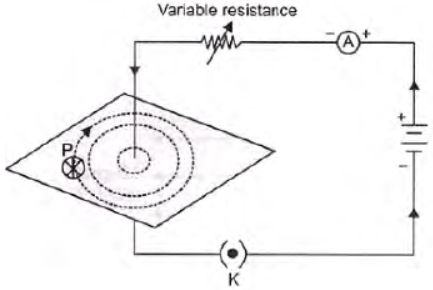
Question. Magnetic field lines are shown in the given diagram.
A student makes a statement that magnetic field at X is stronger than at Y. Justify this statement.
Also, redraw the diagram and mark the direction of magnetic field lines.

Answer: More the density of electric field lines more the strength of magnetic field.

Question. State one main difference between ac and dc. Why ac is preferred over dc for long range transmission of electric power? Name one source each of dc and ac.
Answer: The magnitude and direction of ac remains same whereas a.c. changes its magnitude and direction periodically. Low AC voltage can be increase to high voltage to prevent loss in electric energy during its long distance transmission.
AC generator and DC generator/or cell.
Question. What are magnetic field lines? How is the direction of magnetic field at a point determined? Mention few important properties of magnetic field lines.
Answer: Magnetic field lines are the path traced by north pole in a magnetic field. A tangent drawn to the magnetic field lines gives the direction of magnetic field at that point.
a. Magnetic field lines emerge out from the N-pole and go to the south pole and from S-pole to N-pole inside the magnet forming the closed curve.
b. They do not intersect each other.
Question. State the rule which you use to find the direction of induced current or state Fleming’s right hand rule.
Answer: Fleming’s right hand rule gives the direction of current produced in a conductor. According to Fleming’s right hand rule, if we stretch right hand thumb, forefinger and middle finger perpendicular to each other in such a way that thumb points the direction of force on a conductor and forefinger points the direction of magnetic field then middle finger will point the direction of current produced in the conductor.
Question. What is the nature of magnetic field produced by a straight current carrying circular coil? Explain with the help of an experiment.
Answer: Bend a wire in the shape of a circular loop. Pass the coil through a cardboard. Connect the free ends of the coil to a battery and a key. Sprinkle some iron filings on the cardboard. Put on the key you will find that the iron filings arrange themselves in the form of concentric circles. The magnetic lines of forces near each segment of wire are circular and form concentric circles, whereas the lines of force near the centre of the coil are almost straight lines.
The right hand thumb rule predicts the direction of this magnetic field it states “Grasp the conductor in the right hand with the thumb pointing in the direction of current, and then the direction in which the fingers curl gives the direction of the magnetic field.”
Question. Name and state the rule to determine the direction of a force experienced by a current carrying straight conductor placed in a magnetic field which is perpendicular to it. Name a device that uses current-carrying conductor and magnetic field.
Answer: Fleming’s left hand rule gives the direction of force experienced by a current carrying straight conductor placed in a magnetic field which is perpendicular to it. According to Fleming’s left hand rule if we stretch our left hand thumb, forefinger and middle finger in such a way that forefinger points the direction of magnetic field, middle finger points the direction of current then thumb will give the direction of force on the conductor.
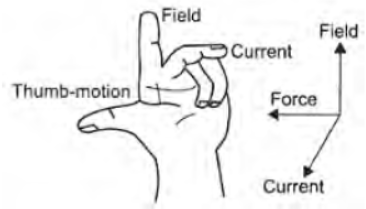
Question. Define a solenoid. How is it different from a coil?
Answer: A coil of many circular turns of insulated wire wrapped closely in the form of a cylinder is called a solenoid.
In a current carrying solenoid magnetic field is same at all points inside it, i.e. field is uniform inside the solenoid. The magnetic field inside a coil vary.
Question. On what factors does the force experienced by a current carrying conductor placed in a uniform magnetic field depend?
Answer: The force experienced by a current carrying conductor in a magnetic field depends upon—
a. length of the conductor
b. current in the conductor
c. magnetic field in which it is kept
Question. What is meant by the term “magnetic field lines”?
List two properties of magnetic field lines.
Answer: Magnetic field lines are the path traced by a hypothetical north pole in the magnetic field of another magnet or current carrying conductor if it is allowed to do so.
Properties:
a. No two field lines are found to cross each other.
b. Outside the magnet magnetic field lines travel from N-pole to S-pole and inside the magnet from S-pole to N-pole.
Question. With the help of a neat diagram, describe how you can generate induced current in a circuit.
Answer: Take a coil of large number of turns and connect the two ends of the coil with a galvanometer. Galvanometer is a device used to detect the presence of current.
Now bring N pole of a strong magnet towards the coil. There is a momentary deflection in the galvanometer. Now bring the N pole away from the coil, again there is a deflection in the opposite direction in the galvanometer deflection in the galvanometer shows that a current is induced in the coil. The induced current can be produced by keeping magnet stationary and giving movement to the coil, or when both have a relative motion w.r.t. each other.

Question. Why is series arrangement not used for domestic circuits?
Answer: In domestic circuits, all appliances are connected in parallel not in series because
a. In series combination same current is passed through each appliances whereas they may need different current.
b. If one appliance fails to work then circuit will be broken and all other appliances will stop to work.
c. If one appliance is switched off others also will stop working i.e. all appliance will work together whether we require it or not.
d. In series combination total potential difference is divided among all appliances in proportion to their resistance. So all appliance will not get required voltage to operate efficiently.
Question. Explain what is short-circuiting and overloading in an electric supply.
Answer: When live wire and neutral wire come in contact with each other short circuit takes place. This may be due to fault in electric circuit or when insulation of wire is damaged. During the short circuiting current increasesabruptly due to decrease in resistance in the circuit.
This short circuiting leads the spark and house may catch fire.
Over loading means to draw the current by all electric appliances in the circuit more than maximum permitted value of the current, overloading also leads the heating of wires which may damage the insulation of wires.
Question. State the characteristics of magnetic force.
Answer: If a charge is moving in a magnetic field then it experiences a force known as magnetic force F = qVBsinq , B is magnetic force, q is angle between B and V. This magnetic force
a. acts only when charge is moving
b. does not act when charge is at rest
c. is maximum when charge is moving perpendicular to the magnetic field
d. does not act when charge is moving in the same direction of magnetic field.
Question. The flow of a current in a circular loop of a wire creates a magnetic field at its centre. How can existence of this field be detected? State the rule which helps to predict the direction of this magnetic field.
Answer: Take a cardboard and fix it. Now pass a thick copper wire having two holes giving the wire a circular shape.
Connect the two ends of the wire with a cell and plug key. Sprinkle iron filings uniformly on the cardboard.
Now plug in key and tap the cardboard gently a number of times. The iron filings arrange themselves in the pattern of concentric circles. Near each segment of wire whereas near the centre of the coil these arrange almost in straight lines. Right hand thumb rule gives the direction of magnetic field i.e. if we hold a current carrying conductor in our right hand in such way that thumb points the direction of current, then the curls of the fingers encircling the conductor will give the direction of magnetic field around the conductor.
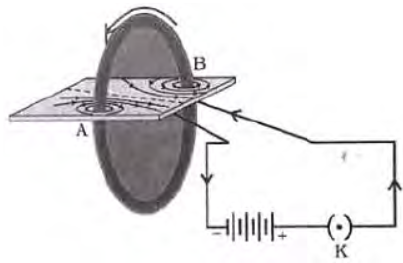
Question. How does the strength of the magnetic field at the centre of a circular coil of wire depend on: (i) the radius of the coil (ii) the number of turns of wire in the coil (iii) the strength of the current flowing in the coil?
Answer: The magnetic field at the centre of a current carrying circular coil is
a. inversely proportional to the radius ‘a’ of the coil B α 1/a
b. directly proportional to the number of turns in the coil
c. directly proportional to the current I in the coil B α I .

Question. Draw the pattern of lines of force due to a magnetic field associated with a current carrying conductor.
State how the magnetic field produced changes a. with an increase in current in the conductor and b. the distance from the conductor.
Answer: The pattern of magnetic lines of force is in the form of concentric circles around the current carrying wire.

a. with the increase in current, magnetic field around the conductor also
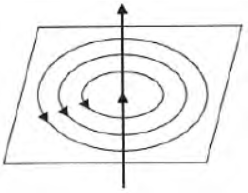
b. near the current carrying conductor magnetic field is more which decreases with increase in distance from the wire.
Question. Identify the poles of the magnet in the given figure (1) and (2).

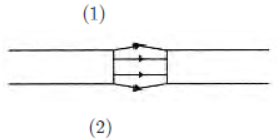
Answer: The figure is as shown below :
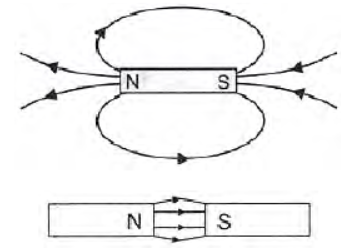
Question. What are permanent magnet and electromagnet?
Give two uses of each.
Answer: Permanent Magnet: It has constant magnetic field around it. e.g. generator, loud speaker.
Electromagnet: When a soft iron is placed in a solenoid it gets magnetised till there is current in solenoid, e.g. electric bells, cranes.
Question. Explain briefly different methods of producing induced emf.
Answer:
a. By mutual induction: If we change current in one coil, a current is induced in the neighbouring coil.
b. By giving a relative motion to a magnet and coil in its neighbourhood.
Question. What is the role of fuse, used in series with any electrical appliance? Why should a fuse with defined rating not be replaced by one with a larger rating?
Answer: Fuse wire is safety device to prevent electrical devices due to short circuiting or overloading. The fuse wire is rated for a maximum current which has high resistance and low melting point. When there is short circuiting large current is passed in the circuit. Due to large current in fuse wire heat is produced and by melting fuse wire breaks the circuit to keep other appliances safe.
If a fuse wire is replaced by an ordinary copper wire which has low resistance and high melting point it will not melt and domestic appliance may get damaged due to excessive heat due to short circuiting or overloading.
Question. A magnetic compass shows a deflection when placed near a current carrying wire. How will the deflection of the compass get affected if the current in the wire is increased? Support your answer with a reason.
Answer: If current is increased magnetic field around this conductor increases, the deflection in the galvanometer also increases.
Question. No two magnetic field lines can intersect each other. Explain.
Answer: If two magnetic field lines intersect each other then at the point of intersection there will be two different tangents pointing two different directions of magnetic field at a point which is not possible.
Question. (a) Mention the colour code used for live, neutral and earth wire.
(b) You want to connect a 2 kW electric oven in the electric circuit. In which power line would you connect it and why? What may happen if you connect it wrongly in the other power line?
Answer:
(a) Live wire – Red
Neutral wire – Black
Earth wire – Green
(b) 2 kW electric iron draws large current. If it is connected to a socket of 5Athen fuse will be blown. So it is connected in power socket of 15 A.
Question. How does the strength of the magnetic field at the centre of a circular coil of a wire depend on:
a. radius of the coil
b. number of turns in the coil.
Answer: Magnetic field strength at the centre of a circular coil of a wire carrying current
a. magnetic field decreases with increase in radius.
b. α n, i.e. magnetic field increases with increase in number of turns.
Question. What is meant by the term magnetic field lines? List any two properties of magnetic field lines.
Answer: The imaginary path traced by N-pole of a magnet in a magnetic field is called magnetic field lines.
Properties:
a. Two magnetic field lines never intersect each other.
b. Magnetic field lines are crowded near the poles and near the mid part of magnets the density of magnetic lines of force decreases.
Question. Why does a current carrying Conductor experiences a force when it is placed in a magnetic field? State Fleming’s left hand rule.
Answer: When a current carrying conductor is placed in a magnetic field it experiences a force due to interaction between the two magnetic fields due to current carrying , conductor and given magnetic field of a magnet. If we hold our thumb, forefinger, and middle finger perpendicular to each other in such a way that forefinger points the direction of magnetic field, middle finger points the direction of charge q (direction of current in conductor), then thumb will point the direction force acting upon the conductor.
Question. An electron enters a uniform magnetic field at right angles to it as shown in the figure below. In which direction will this electron move? State the rule applied by you in finding the direction of motion of the electron.
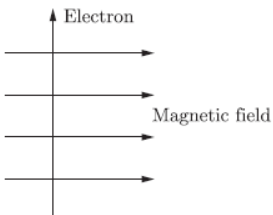
Answer: As per Fleming’s left hand rule the electron will experience a force upward. So it will move perpendicularly outward.
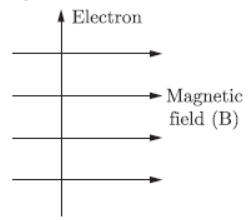
Fleming’s left hand rule -stretch the forefinger, the middle finger and the thumb of the left hand mutually perpendicular to each other in such a way that forefinger points the direction of magnetic field, middle finger points the direction of current (opposite to the flow of electrons) then the thumb will point the direction of force on the conductor (charge).
Long Answer Type Questions :
Question. (a) Describe an activity to show the pattern of magnetic field fines of a bar magnet, with the help of a cardboard piece and iron filings.
(b) Compare the field of a bar magnet with that of a solenoid with the help of figure.
Answer:
(a) Fix a white paper sheet on a drawing board with the help of copper pins. Keep a bar magnet in the centre of the paper and sprinkle some iron filings uniformly around the bar magnet. Tap the board gently. Iron filings arrange themselves in a pattern as shown in figure. These iron filings near the bar magnet align themselves along the magnetic field lines.
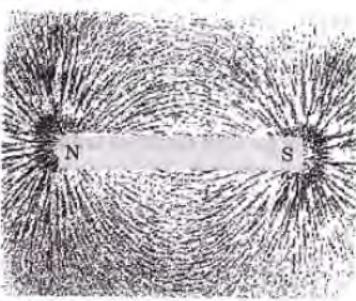
(b) A current carrying solenoid behaves as a bar magnet one end of the solenoid behaves like a N pole and another end as S pole like two poles in bar magnet, so the field lines of a solenoid and bar magnet appear same in many ways:
(i) Magnetic lines of force inside the body is strong and uniform.
(ii) In both the cases stronger field exists at the poles compared to the middle part.
Dissimilarities
(i) In bar magnet, the poles are not exactly at the ends of the magnet, in solenoid poles can be considered to be lying at the edges.
(ii) In bar magnet, magnetism is permanent but in solenoid it exists only till there is a current in solenoid.
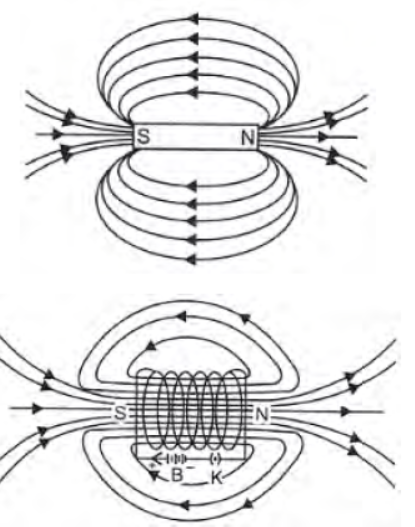
Question. (a) Describe an activity to determine the direction of magnetic field produced by a current carrying straight conductor. Also show that the direction of the magnetic field is reversed on reversing the direction of current.
(b) An a -particle, (which is a positively charged particle) benters, a uniform magnetic field at right angles to it as shown below. Stating the relevant principle explain in which direction will this a-particle moves?
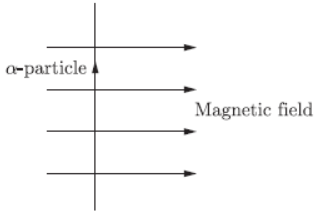
Answer:
(a) Fix a cardboard and pass a straight wire through a hole in cardboard and connect the two ends of the wire with a cell through a rheostat and key with a cell. Sprinkle iron filings uniformly on the card board. Pass the current in the wire and gently tap the card board. You would find that iron filings align themselves in concentric circles around the copper wire which represents the magnetic field around the current carrying conductor. The direction of magnetic field changes on reversing the direction of current.
(b) According to Fleming’s left hand rule the force on the oc-particle will be inwards perpendicular to the plane of paper, so \-particle will move in the direction of force.
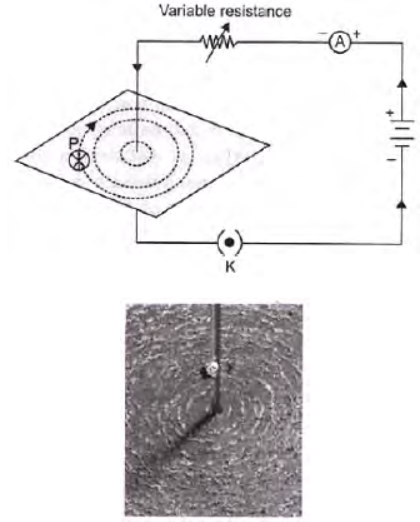
Question. Explain the meanings of the words “electromagnetic” and “induction” in the term electromagnetic induction.
List three factors on which the value of induced current produced in a circuit depends. Name and state the rule used to determine the direction of induced current.
State one practical application of this phenomenon in everyday life.
Answer: The word electromagnetic means that an electric potential dipole is being produced in a coil due to change in magnetic field. The word induction means that the current has been induced. The value of induced current produced in a circuit depends on the following factors:
a. number of turns in given coil
b. area of each turn in coil
c. rate of change of magnetic field.
The rule is Fleming’s right hand rule. Stretch the thumb, forefinger and middle finger of righthand perpendicular to each other that forefinger indicates the direction of magnetic field, thumb gives the direction of motion (or force) of the conductor, then middle finger will point the direction of induced current.
Application: AC generator or DC generator.
Question. What is a solenoid? Sketch magnetic field lines produced around a current carrying solenoid. Mark the region where field is uniform. Compare its field with that of a bar magnet.
Answer: A solenoid is a large number of insulated turns of the copper wire in the shape of helix (or cylinder).
The patterns of the magnetic field lines around a current carrying solenoid is as given in figure. At the centre of the solenoid the magnetic field is uniform and magnetic field lines are parallel.
Similarities:
In both the cases of a current carrying solenoid and bar magnet the magnetic lines of forces inside the body is strong and uniform. In both the cases there exists stronger magnetic field at the poles compared to the middle parts.
Dissimilarities:
(i) The poles in a bar magnet do not exist at the extreme ends of the magnet whereas in solenoid the poles can be considered to be lying at the edge.

(ii) In a bar magnet, magnetism is retained naturally, but in solenoid magnetism is there so long current flows through it.
Question. (a) State the function of ‘a fuse’ in an electric circuit. How is it connected in the domestic circuit?
(b) An electric fuse of rating 3A is connected in a circuit in which an electric iron of power 1.5 kilo watt is connected which operates at 220 V. What would happen? Explain.
Answer:
(a) Fuse is a safety device to prevent the damage of electrical devices from short circuit or overloading.
A fuse is connected in series with the circuit.
(b) Given Power P = 1.5 kW = 1500 Watt and V = 220 Volts.
Power P = VI ⇒ I = p/v = 1500/220 = 6.8A
The rating of fuse is 3A which is lesser the current drawn by electric iron 6.8 A. So fuse wire will be blown.
Question. (a) Draw magnetic field lines of a bar magnet. “Two magnetic field lines never intersect each other”. Why?
(b) An electric oven of 1.5 kW is operated in a domestic circuit (220 V) that has a current rating of 5 A. What result do you expect in this case? Explain.
Answer:
(a) Magnetic field lines around a bar magnet.

If the two magnetic field lines would intersect with each other than at that point there will be two different directions of magnetic field which is not possible.
(b) Given Power P = 1.5 kW = 1500 Watt and V = 220 Volts.
Current drawn I = (P/Vh) =(1500/220)A
I = 7 A (approx).
As the current drawn by the oven is 7 A which is larger than the rating of the fuse (5A) so fuse will blow off and circuit will be broken.
Question. (a) Name two electrical appliances of daily use in which electric motor is used.
(b) Name and state the principle on which an electric motor works.
Answer:
(a) Drill machine, fan, grinder
(b) An electric motor works on the Fleming’s left hand rule. When a current carrying coil is placed in a magnetic field it experience a torque due to which it rotates.
Fleming’s left hand rule-stretch left hand, thumb, forefinger and middle finger perpendicular to each other in such a way that forefinger indicates the direction of magnetic field, middle finger indicates the direction of current in the conductor then thumb will point the direction of force on the conductor,
Question. (a) What is an electromagnet? What does it consist of?
(b) Name one material in each case which is used to make a : (i) permanent magnet (ii) temporary magnet.
(c) Describe an activity to show how you can make an electromagnet in your school laboratory.
Answer:
a. A soft metal core made into a magnet by the passage of electric current through a coil surrounding it. It consists a soft iron core or its alloy and a solenoid conductor coil around the
core.
b. (i) To make a permanent magnet alloy Alnico is used. (ii) Soft iron is used to make temporary magnet.
c. Take a long nail and put it into a solenoid of insulated copper wire. Pass the strong current in the solenoid the nail inside the solenoid becomes magnetised. This is called electromagnet.
Question. (a) A coil of insulated copper wire is connected to a galvanometer. What will happen if a bar magnet is:
(i) pushed into the coil with its north pole entering first?
(ii) withdrawn from inside the coil?
(iii) held stationary inside the coil?
(b) Name the above phenomenon and mention the name of the scientist who discovered it. State the law that relates the direction of current in the coil with the direction of motion of the magnet.
Answer:
a. (i) Galvanometer gives a deflection
(ii) Again galvanometer gives a deflection but in opposite direction.
(iii) No current is induced in the coil so no deflection in the galvanometer.
b. Electromagnetic induction (EMI):
Faraday discovered it. Fleming’s right hand rule gives the direction of induced current in the coil.
If we stretch right hand thumb, forefinger and middle finger perpendicular to each other in such a way that thumb gives the direction of motion of the conductor, forefinger gives the direction of magnetic field then middle finger will give the direction of current induced in the conductor.
Question. (a) Draw a schematic labelled diagram of a domestic wiring circuit which includes (i) a main fuse (ii) a power meter (iii) one light point and (iv) a power plug.
(b) Why is it necessary to connect an earth wire to electric appliances having metallic covers?
Answer:
a.

b. The earth wire carry current due to any leakage or defective electric appliance to the earth keeping human beings safe preventing from any electric shock.

c. Properties of magnetic field lines
(i) They emerge from the north pole and merge at south pole of a bar magnet.
(ii) They do not intersect with each other.
(iii) They emerge and merge normal to the surface of magnet
Question. (a) State Fleming’s left hand rule.
(b) Write the principle of working of an electric motor.
(c) Explain the function of the following parts of an electric motor.
(i) Armature (ii) Brushes (iii) Split ring
Answer:
(a) Fleming’s left hand rule state that if the thumb, forefinger and middle finger are stretched perpendicular to each other in such a way that forefinger indicates the direction of magnetic field, middle finger indicate the direction of current in the conductor then thumb will indicate the direction of force on the conductor.
(b) The principle of electric motor is that when a current carrying coil is placed in a magnetic field it experiences a torque and if the coil is allowed it rotates in the magnetic field.
(c) Function of the parts of an electric motor :
(1) Armature: Armature is a large number of turns of the coil on soft iron core which rotates in magnetic field.
(2) Brushes: They allow current to pass from external source to armature.
(3) Split rings: Split rings are of copper, splits into two halves and make a connection between armature and brushes.
Question. (a) What is the function of an earth wire in electrical instruments? Why is it necessary to earth the metallic electric appliances?
(b) Explain what is short-circuiting and overloading in an electric supply.
(c) What is the usual capacity of the fuse wire in the line to feed:
(i) lights and fans?
(ii) appliances of 2 kW or more power?
Answer:
(a) We can get an electric shock on touching a faulty appliance, caused by the leakage of current from the appliance. Earthing provides a safety measure against the electric shock caused by the leakage of current. Earth wire brings this leakage current to the ground by a earth wire and we remains safe.
(b) Short circuiting takes place when a live wire and neutral wire come in contact with each other due to damage of insulation of these wires. Due to short circuiting, resistance of the circuit becomes minimum and a very high current is passed through the circuit which produces spark and heat and may lead a fire in the house. Overloading when the amount of current flowing through the circuit exceeds the rating of the protective devices it is said that circuit is overloaded. It is a situation in which many electrical appliances are connected
in a single socket. It will draw more current, may lead the burst of fire in building.
(c) (i) Bulbs, fans etc. – 5A, (ii) Heater – Micro-oven, Electric iron – 15A
Question. (a) Describe an activity to demonstrate the pattern of magnetic field lines around a straight conductor carrying current.
(b) State the rule to find the direction of magnetic field associated with a current carrying conductor.
(c) What is the shape of a current carrying conductor whose magnetic field pattern resembles that of a bar-magnet ?
Answer:
(a) Aim : To study the magnetic field due to a straight current carrying conductor.
Apparatus Required : A thick conducting wire, battery, rheostat, magnetic needle, ammeter (0-5 A), key, a cardboard, a stand to hold the wire, iron filings and sprinkler of iron filings.
Procedure :
1. Attach the thick wire through a hole at the middle of the cardboard and clamp it in a stand.
2. Attach the ends of the wire through a key, variable resistor and an ammeter on either side of a battery and hold it vertically and perpendicularly to the board.
3. Spread the iron filings uniformly on the cardboard and place the magnetic needle on the board.
4. Close the key and tap the cardboard slightly and observe the orientation of iron filings.
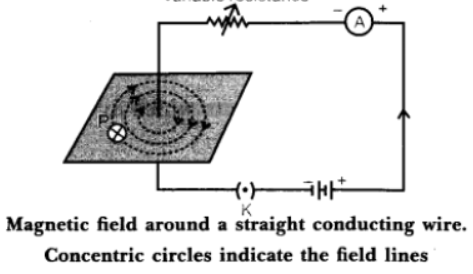
Observation :
1. Just on closing the key, the iron filings are aligned in the pattern of concentric circles around the wire.
Conclusion :
1. Current carrying conductor is a source of magnetic field.
2. The magnetic field is in the form of concentric circles whose centre lies on the wire.
(b) Right-Hand Thumb Rule. This rule is used to find the direction of magnetic field due to a straight current carrying wire. img
It states that if we hold the current carrying-conductor in the right hand in such a way that the thumb is stretched along the direction of current, then the curly finger around the conductor represent the direction of magnetic field produced by it. This is known as right-hand thumb rule.
Direction of Field Lines due to current carrying straight conductor is as shown in figure.
(c) Solenoid.
Question. (a) Describe activity with labelled diagram to show that a current carrying conductor experience a force in a magnetic field.
(b) State the rule to determine the direction of force.
Answer:
(a) Without using a magnet, magnetic field can be produced by flowing the current through a straight conductor or a solenoid.
Aim : To show that magnetic field exerts a force on a current carrying conductor.
Apparatus required : Aluminium rod, stand, strong horse shoe magnet, cell, key and connecting wires. img
Procedure :
1. Hang the aluminium rod with the help of clamp stand such that it passes between the North and South pole of the magnet with the magnetic field directed upwards and the rod being horizontal and perpendicular to the field.
2. Connect the aluminium rod in series with a battery, a key as shown in figure.
3. Plug the key, the current flows through the rod from Q to P and observe the direction of motion of the rod.
4. Reverse the direction of current by reversing the battery connection. Again observe the direction of displacement of aluminium rod.
5. Restore the original direction of current and change the direction of field vertically downwards by interchanging the two poles of the magnet. Observe the deflection of rod again.
6. Place the wire parallel to magnetic field and allow the current to pass through it. Check the deflection of rod again.
Observation :
1. On plugging the key in step 3, the aluminium rod moves towards left.
2. In step 4, rod displaces towards right.
3. In step 5, rod moves towards right again.
4. In step 6, rod does not move in any direction.
Conclusion :
1. Magnetic field exerts a force on a current carrying conductor.
2. The force exerted on the current carrying conductor depends upon the direction of current and direction of magnetic field acting on it.
3. Displacement of the rod or the magnetic force on it is largest when the direction of current is at right angle to the direction of magnetic field.
4. When current carrying conductor is placed parallel to the magnetic field, it experiences no force.
(b) Direction of force experienced by a current carrying straight conductor placed in a magnetic field which is perpendicular to it is given by Fleming’s left hand rule.
Stretch the thumb, forefinger and middle finger of left hand in such a way that they are mutually perpendicular to each other. If the forefinger points in the direction of magnetic field and the middle finger in the direction of current, then the thumb will point in the direction of motion or the force acting on the conductor.
Question. Two coils C1 and C2are wrapped around a non conducting cylinder. Coil C1is connected to a battery and key and C2 with galvanometer G. On pressing the key (K), current starts flowing in the coil C1State your observation in the galvanometer:
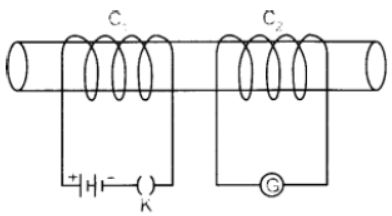
(i) When key K is pressed on
(ii) When current in the coil C1 is switched off.
(iii) When the current is passed continuously through coil C1
(iv) Name and state the phenomenon responsible for the above observation. Write the name of the rule that is used to determine the direction of current produced in the phenomena.
Answer:
(i) When key is pressed on, the galvanometer needle deflects momentarily in one direction.
(ii) When the current in the coil C1 is switched off, the galvanometer needle deflects again momentarily but in opposite direction to that in the previous case.
(iii) When current is passed continuously through coil C1 , no deflection is observed in the galvanometer.
(iv) The phenomenon responsible for the above observations is electromagnetic induction.
Electromagnetic Induction: The process, by which a changing magnetic field in a conductor induces a current in another conductor placed nearby, is called electromagnetic induction.
• Fleming’s right hand rule is used to determine the direction of current produced in the phenomena ofelectroynagnetic induction.
Question. Two coils of insulated copper wire are wound over a non -conducting cylinder as shown. Coil I has larger number of turns.
(i) Write your observations when,
(a) key K is closed,
(b) key K is opened.
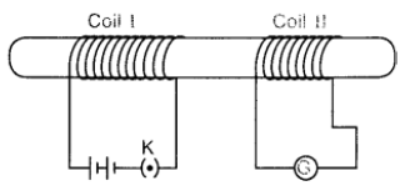
(ii)When the current is passed continuously through coil I.
Give reason for your observations.
(iii) Name and state the phenomenon responsible for the above observation.
(iv) Write the name of the rule that is used to determine the direction of current produced in the phenomenon.
(v) Name the two coils used in this experiment.
Answer:
(i) (a) When key is closed, the galvanometer needle deflects momentarily in one direction. , Reason: When key is closed, magnetic field lines around coil 2 increases momentarily. This causes an induced current to flow through it and hence deflection occurs in one direction.
(b) When key is opened, the galvanometer needle deflects again momentarily but in opposite direction.
Reason: When key is open, magnetic field lines around coil 2 decreases momentarily. This causes an induced current to flow in opposite direction. Hence, deflection occurs in opposite direction.
(ii) When current is passed continuously through coil I, no deflection is observed in the galvanometer.
Reason: There will be no change in magnetic field lines passing through the coil 2. Hence, no induced current will be set up in coil 2.
(iii) The phenomenon observed in above cases is electromagnetic induction. It is a process by which a changing magnetic field in a conductor induces a current in another conductor placed nearby.
(iv) Fleming’s right hand rule
(v) Coil I – Primary coil Coil II – Secondary coil
Question. (i)With the help of an activity, explain the method of inducing electric current in a coil with a moving magnet. State the rule used to find the direction of electric current thus generated in the coil.
(ii) Two circular coils P and Q are kept close to each other, of which coil P carries a current.
What will you observe in Q
(a) if current in the coil P is changed?
(b) if both the coils are moved in the same direction with the same speed? Give reason.
Answer:
(i) Take a coil AB of wire having a large number of turns.
Connect the ends of coil to a sensitive galvanometer as shown in figure.
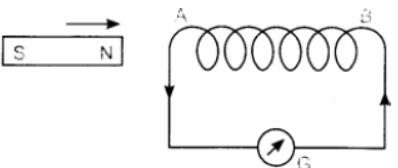
Take a strong bar magnet and move its north pole towards the end ‘A’ of coil. The deflection in the needle of galvanometer indicates that the induced current flows in the circuit in anticlockwise direction. The end A of the coil behaves as a north pole.
When north pole of the magnet moves away from the coil, the deflection in the galvanometer occurs but in opposite direction.
Similar observations can be made when south pole of the magnet is moved towards the coil or away from it.
When magnet is kept at rest with respect to the coil, the deflection in the needle of galvanometer drops to zero.
Thus, the motion of a magnet, with respect to the coil, produces an induced potential difference which sets up an induced electric current in the circuit.
The direction of electric current thus generated in the coil can be found by using the Fleming’s right-hand rule.
(ii)Fleming’s right-hand rule: Stretch the thumb, forefinger and middle finger of right hand in such a way that they are mutually perpendicular to each other. If the forefinger indicates the direction of magnetic field and thumb shows the direction of motion of the conductor, then the middle finger will indicate the direction of induced current.
(a) If current in the coil P is changed, the magnetic field lines of forces linked with coil Q also change. So, induced potential difference is set up in the coil Q. This results in induced electric current in coil Q which opposes the change in current in coil P.
(b) If both the coils are moved in the same direction with the same speed, there will be no relative motion between them and hence, there will be no change in magnetic field lines of force associated with the secondary coil. Hence, no current will be induced in the coil.
Question. (a) Mention the effect of electric current on which the working of an electrical fuse is based.
(b) Draw a schematic labelled diagram of a domestic circuit which has a provision of a main fuse, meter, one light bulb and a socket.
(c) Explain the term overloading of an electric circuit.
Answer:
(a) Heating effect of electric current.
(b) Domestic circuit wiring consists of a main fuse, meter, one light bulb and a socket.
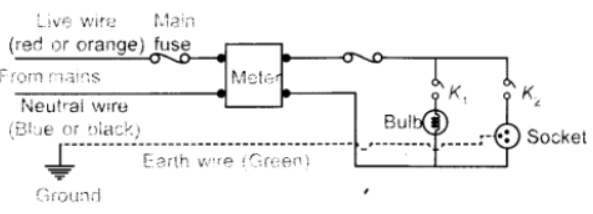
(c) The flow of large amount of current through the circuit beyond its bearing capacity due to use of many high power rating devices at the same time is called overloading.
Question. (a) Explain why there are two separate circuits one for high power rating appliances and other for low power rating appliances.
(b) A domestic circuit has 5A fuse. How many bulbs of rating 100W, 220V can be safely used in this circuit? Justify your answer.
Answer:
(a) Two separate circuits are formed in the domestic wiring, one for high power rating appliances called power circuit and other for low power rating called lightning circuit.
Power circuit: The circuit which draw heavy current (15 A) from mains and used for high power rating devices such as microwave, oven, air conditioners, geysers, washing machine, etc., is known as power circuit. Lightning circuit: The circuit which draw small amount of current from the mains and used for low power rating devices such as bulb, tube light, fans, T.V., Computer, etc. having a current rating of 5 A is known as lightning circuit.
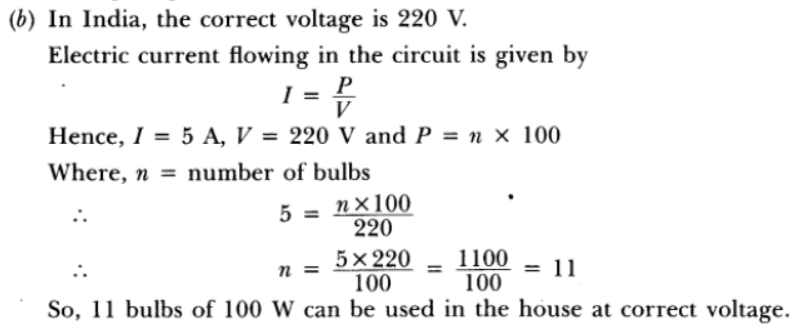
Question. (i) Design an activity with the help of two nails, very thin aluminium strip, a 12 V Battery and a key to illustrates.
(ii) Cable of a microwave oven has three wires inside it which have insulation of different colours black, green and red. Mention the significance of the three colours and potential difference between red and black one.
Answer:
(a) Aim: How electric fuse works?
Apparatus required : Two nails, card board, very thin aluminium strip, a 12 V battery, key and connecting wires.
Procedure:
1. Insert the two nails vertically on the card board.
2. Take very thin aluminium strip and tie it between the nails.
3. Make a circuit as shown in figure with 12 V battery and key with the help of connecting wires.
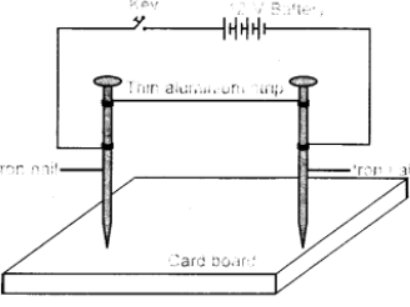
4. If there are any fans running in the room, switch them off.
5. Now switch on the current in the circuit by pressing the key or by moving the switch of the ‘ON’ position.
6. Now pass the current through the circuit for some time. Observe the strand of aluminium strip between the two nails carefully.
Observation: The strand of aluminum strip melt and break quickly on passing the large electric current through it.
Conclusion: When current flows through the circuit, exceed the rating of aluminium strip, i.e. safe limit, its temperature increases. This make it overheated. As a result, aluminium strip melts and breaks the circuit. Hence, very thin aluminium strip between the two nails acts as a fuse wire. This activity shows that how fuse works.
(b) Significance of insulation colour:
1. Red colour insulation wire – Live wire
2. Black colour insulation wire – Neutral wire
3. Green colour insulation wire – Earth wire
Live wire is at higher potential of 220 V while neutral wire is at zero potential. So, potential difference between red and black insulation wire is 220 V.
Question. Observe the figure given below and answer the following questions:
(a) Write the special name given to the coil AB which has many circular turns of insulated copper wire.
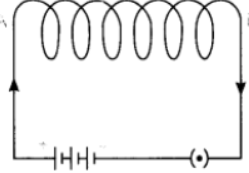
(b) State the nature of magnetic field inside AB when a current is passed through it.
(c) Redraw the diagram and sketch the pattern of magnetic field lines through and around AB.
(d) List two factors on which the strength of the magnetic field produced by AB depends.
(e) What is the effect of placing an iron core in the coil AB?
Answer:
(a) Solenoid.
(b) Uniform magnetic field. img
(d) (i) Magnitude of current flowing through it.
(ii) Number of turns of a circular coil.
(e) It becomes an electromagnet.
Question. (a) Describe an activity to demonstrate the pattern of magnetic field lines around a straight conductor carrying current.
(b) State the rule to find the direction of magnetic field associated with a current-carrying conductor.
(c) What is the shape of a current-carrying conductor whose magnetic field pattern resembles that of a bar-magnet?
Answer:
(a) Aim: To study the magnetic field due to a straight current-carrying conductor.
Apparatus Required: A thick conducting wire, battery, rheostat, magnetic needle, ammeter (0-5 A), key, a cardboard, a stand to hold the wire, iron filings and sprinkler of iron filings.
Procedure:
1. Attach the thick wire through a hole at the middle of the cardboard and clamp it in a stand.
2. Attach the ends of the wire through a key, variable resistor and an ammeter. on either side of a battery and hold it vertically and perpendicularly to the board.
3. Spread the iron filings uniformly on the cardboard and place the magnetic needle on the board.
4. Close the key and tap the cardboard slightly and observe the orientation of iron filings.
around the wire.
Conclusion:
1. A current-carrying conductor is a source of magnetic field.
2. The magnetic field is in the form of concentric circles whose centre lies on the wire.
(b) Right – Hand thumb Rule: Hold the current-Carrying wire in your right hand, such that the thumb indicates the direction of current, then the folded fingers will indicate the direction of magnetic field (lines) surrounding the wire.
Question. (a) Draw a diagram to represent a uniform magnetic field in a given region.
(b) List two properties of magnetic field lines.
Answer:
(a) Equidistant parallel line indicates a uniform magnetic field in a given region.
(b) Properties of magnetic field lines are:
1. The magnetic field lines of a magnet form continuous closed loops, i.e. outside the magnet, they emerge from north pole and merge at the south pole and inside the magnet, the direction of field lines is from its south pole to its north pole.
2. The degree of closeness of field lines indicates the strength of magnetic field.
3. Field lines never cross each other.
Question. Consider a circular loop of wire lying in the plane of the paper. Let the current pass through the loop clockwise. With the help of a diagram, explain how the direction of the magnetic field can be determined inside and outside the loop. Name the law used to find the direction of magnetic field.
Answer: Consider a circular loop of wire of radius r with centre O lying in the plane of the paper. Let the current i pass through the loop clockwise. According to right hand thumb rule, direction of magnetic field due to any portion of small current carrying length of the coil is:
Direction of magnetic field inside the loop — Perpendicular to the plane of paper inwards.
Direction of magnetic field outside the loop — Perpendicular to the plane of paper outwards. im g
So, the direction of magnetic field can be considered as the direction of total magnetic field due to circular coil as current through all the elements will contribute to the magnetic field in the same direction.
Question. Describe an activity to show that the magnetic field lines produced when current is passed through the circular coil.
Answer:
Aim : To study the characteristics of magnetic field produced by a current carrying circular coil at its centre.
Apparatus Required : Rectangular cardboard having two holes, Thick copper circular coils of different radii having known number of turns, key, battery, rheostat, stand, iron filings.
Procedure :
1. Pass the coil through the two holes of cardboard in such a way that half of the loop is above the cardboard and remaining part should be below it and normal to the plane of cardboard.
2. Connect the circuit as shown.
3. Sprinkle iron filings uniformly on the cardboard.
4. Allow the current to pass though the coil by inserting plug in the key.
5. Note the pattern of iron filings that emerges on the cardboard after tapping gently a few times.
(Observation).
6. Place the compass at any point over the pattern of field. Observe the direction of needle.
(Observation 2).
Observations :
1. (a) Iron filings are arranged in the form of concentric circles.
(b) The concentric circles become larger and larger as we move away from the wire.
(c) At the centre of loop, lines are almost straight and perpendicular to the plane of the loop.
Conclusion :
1. The concentric circles at every point of a current carrying circular loop represent the magnetic field around it.
2. Magnetic field line close to the axis of loop is straight and is perpendicular to the plane of the coil.
3. Field lines keep on diverging as we move away from the centre of loop.
Question. (a) Explain any three properties of magnetic field lines.
(b) Give two uses of magnetic compass.
Answer:
(a) Properties of magnetic field lines:
1. Magnetic field lines emerge from N pole and merge at S pole outside a bar magnet and travel from S pole to N pole inside the magnet.
2. These are continuous and closed curves.
3. Two field lines never intersect each other.
(b) Uses of magnetic compass :
1. In navigation it is used to find direction.
2. It is used to detect the magnetic field.
3. It can be used to test whether a substance is magnetic or not.


